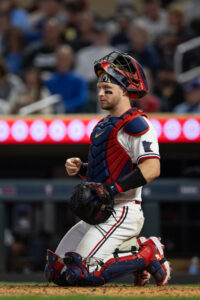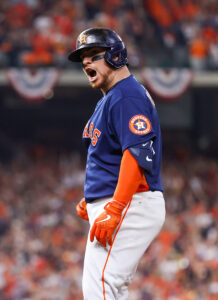For years in Minnesota, the catching position was the strongest on the roster. Hometown kid and former No. 1 overall pick Joe Mauer went from ballyhooed prospect to three-time batting champion and 2009 American League MVP. He solidified the spot for a decade, hitting .323/.405/.469 in more than 5000 plate appearances from 2004-13.
When concussions forced Mauer over to first base, the Twins turned things over to a series of veterans as they struggled to develop an in-house replacement. Kurt Suzuki and Jason Castro both inked multi-year deals to serve as the starting catcher in Minnesota. Those contracts actually panned out reasonably well; Suzuki hit .263/.316/.364 in three seasons and made the 2014 All-Star team. Castro hit .229/.325/.390 in his three seasons and provided elite defense. Along the way, the Twins succeeded in developing one high-end offensive catcher — Mitch Garver — but struggled to keep him healthy. Garver was eventually traded to the Rangers for Isiah Kiner-Falefa and Ronny Henriquez. Kiner-Falefa was then immediately flipped to the Yankees alongside Josh Donaldson in a swap that netted the Twins Gary Sanchez and Gio Urshela (while shedding the remainder of Donaldson’s $92MM contract).
Somewhat lost in the shuffle during that catching carousel was 2018 second-rounder Ryan Jeffers. The UNC-Wilmington product had a nice debut showing in the pandemic-shortened 2020 season, slashing .273/.355/.436 in a small sample of 62 plate appearances. Jeffers, however, fanned in more than 30% of his plate appearances that year and experienced even more pronounced contact issues in the two subsequent seasons.

From 2021-22, he hit just .203/.277/.384 with a 32.4% strikeout rate. The power was apparent (21 homers, .182 ISO in 529 plate appearances), but Jeffers’ contact issues rendered him a well below-average hitter. The Twins, in win-now mode after a strong 2022 campaign, signed veteran Christian Vazquez to a three-year, $30MM deal that generally aligned with market expectations.
Heading into the 2023 season, Jeffers wasn’t relegated to a traditional backup role, but there was a clear expectation that he and Vazquez would be in a timeshare behind the plate — likely with the defensively superior Vazquez handling a bit more of the workload. Through the season’s first few months, that’s precisely how things played out, too. Vazquez received 202 first-half plate appearances to Jeffers’ 157. Vazquez provided his typical brand of elite defense but hit just .210/.287/.265 in that time. Jeffers, on the other hand, hit .256/.357/.421 — numbers more in line with his intriguing rookie showing from 2020.
Following the All-Star break, the balance of playing time tilted in the other direction. It was Jeffers who found his name called more often, picking up 178 plate appearances to Vazquez’s 153. While Vazquez improved a bit offensively in the season’s second half, Jeffers saw his production soar to heights not seen by a Minnesota catcher in years. In the final two-plus months of the season, the 26-year-old mashed at a .294/.379/.549 clip and belted 10 homers. By measure of wRC+, that was 54% better than the league-average hitter. And considering catchers tend to be about 12% worse than the average hitter, Jeffers’ breakout was all the more eye-catching.
It didn’t appear to be simple small-sample noise, either. Jeffers made notable gains in his contact ability, fanning at a reduced (but still higher-than-average) 26.4% clip post-break last season. That includes a strikeout rate of just 17.1% in the season’s final month. While he didn’t suddenly reduce his chase rate on pitches off the plate, Jeffers took a noticeably more aggressive approach overall and seemed to benefit from it. His 50.3% overall swing rate in September was markedly higher than the 43.7% of pitches at which he’d offered in the five months prior. He’d previously made contact on 57.5% of his chases off the plate and 82.2% of his swings within the strike zone; those jumped to 71.4% and 87.8%, respectively, in the final month of play.
We’re now five weeks into the 2024 season, and Jeffers has picked up right where he left off last September. He’s hitting .300/.393/.556 on the season and has already popped five homers in his 107 plate appearances. His 16.8% strikeout rate is an easy career-low. The more aggressive approach he showed late last year remains in place, as he’s swinging at a 47.4% clip with better contact off the plate and within the zone that he’d shown prior to last September.
Jeffers has made himself veritably indispensable in the Twins’ lineup. He’s appeared in 27 of their 30 games: 14 at catcher and 11 at designated hitter. Manager Rocco Baldelli has begun to bat Jeffers in the top-third of his lineup with regularity. Seventy percent of his plate appearances have come while batting first, second or third this year. Jeffers has long pounded left-handed pitching (career .267/.362/.487), but he’s now hitting .285/.368/.489 against righties dating back to Opening Day 2023 — a wild improvement over the .185/.256/.361 slash he posted versus righties from 2020-22.
And, for all the talk about Vazquez’s defense earlier, it should be noted that Jeffers is hardly a slouch himself in that regard. Statcast was down on his ability to block balls in the dirt last season (five blocks below average), but Jeffers has routinely drawn positive overall grades from Defensive Runs Saved. He’s been better than average in that regard in each other season of his big league career, however, and Jeffers has been an average or better pitch framer in his career as a whole, per both FanGraphs and Statcast. He has a slightly below-average caught-stealing rate in his career, but much of that stems from an ugly 13% caught-stealing rate as a rookie. Jeffers nabbed 25% of thieves in 2023 (league-average was 21%) and is 1-for-5 in 2024 (23% is league-average).
Since last season, there are 75 big league catchers who’ve tallied at least 100 plate appearances. Jeffers’ 146 wRC+ leads the pack by a massive margin; the Contreras brothers check in at 133 (William Contreras) and 132 (Willson Contreras) and stand as the No. 2 and 3 entrants on that list. Yes, it’s still only a sample of 442 plate appearances for Jeffers, but he’s been far and away the best-hitting catcher in the majors going back to last year, quietly topping stars like Will Smith, Adley Rutschman, Sean Murphy and the Contreras brothers on a per-plate-appearance basis. Granted, Jeffers isn’t going to top WAR leaderboards because of his more even timeshare with Vazquez and lesser defensive skills to names like Murphy, Rutschman, Patrick Bailey and others — but he’s nevertheless stepped out as one the game’s premier hitters at his position.
Perhaps the Vazquez addition took some pressure off Jeffers, but the breakout at the plate and the Twins’ efforts to scale back payroll this past offseason do combine to make that signing look superfluous. Vazquez is a flat-out elite defender, but he’s hitting .222/.273/.309 in 421 plate appearances as a Twin. For a team that was up against some pretty noticeable payroll constraints from ownership in the offseason, that $10MM-per-year salary could certainly be allocated in a more efficient way.
That’s not to disparage Vazquez; had Twins ownership merely allowed the front office to maintain last year’s roughly $155MM payroll, his salary wouldn’t even be all that cumbersome to manage — and there’s surely intangible benefit to him working with Jeffers and with the team’s pitching staff. Still, the Twins spent relatively heavily to install a starting-caliber option behind the dish, only to see one of their young, in-house options emerge as the cornerstone backstop they’d been seeking all along.
Jeffers remains highly affordable for the Twins, earning just $2.425MM this season in his first trip through arbitration. He’s well on his way to earning a major raise on top of that salary if he can continue to hit as he has going back to Opening Day 2023. He’ll be arb-eligible twice more and is controllable through the 2026 season. As a Boras Corporation client, Jeffers doesn’t stand out as the likeliest candidate to sign a long-term deal, but it’s hard to imagine the Twins wouldn’t be interested in hammering out some kind of deal to keep him in Minneapolis longer than he’s currently slated to stay.
